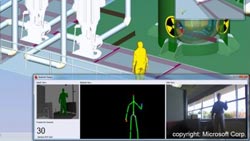Kinect Makes Dangerous Work Processes Safer

<br>
Kinect technology recognizes a person's movements and posture and transfers them to an avatar in a virtual environment. In the same way that a player moves intuitively within the scenes of a computer game, technicians can use Kinect to simulate movements in the workplace.
In its Product Lifecycle Management Software, Siemens Industry already provides interfaces to systems that precisely measure people's movements. Because such solutions are frequently complex, however, Siemens has now developed a version based on the Kinect sensor that is more user-friendly, although not as precise. The new solution makes the system available for other industrial applications, such as the planning of dangerous tasks.
Only a few major industries currently use systems that digitally track movements. The automotive industry is one example, which employs such systems to make assembly line workplaces more ergonomic or to design vehicle interiors. With the help of multiple cameras, electromagnetic sensors or full-body suits, the systems can measure the movements of people wearing special markers to within a single millimeter.
The technology is complex and can only be operated by appropriately trained staff. To develop a simpler system based on Kinect technology, the engineers from Siemens had to appropriately process the data. Although the Kinect sensor recognizes movements, it doesn't measure them precisely. That's why the developers use libraries containing simulation models for typical movements and combine these models with the information supplied by the Kinect sensor.
The first application to be created was a solution for planning service and maintenance work at nuclear power plants in the U.S. The application aims to ensure workers are exposed to a level of radiation that is as low as reasonably achievable (ALARA). To do this, technicians or planners operate the Kinect sensor-equipped simulation program and carry out specific work within a virtual environment. In reality, these environments would be exposed to radiation due to radioactivity. The program calculates the radiation dose that the virtual technician receives. The system helps the planners vary the individual work steps and the design of the workplace in order to reduce the dose to the lowest reasonably achievable level. Similarly, the system could also be used to plan work in chemically contaminated environments or to conduct traditional ergonomics tests.
Media Contact
More Information:
http://www.siemens.com/innovationnewsAll latest news from the category: Information Technology
Here you can find a summary of innovations in the fields of information and data processing and up-to-date developments on IT equipment and hardware.
This area covers topics such as IT services, IT architectures, IT management and telecommunications.
Newest articles

Combatting disruptive ‘noise’ in quantum communication
In a significant milestone for quantum communication technology, an experiment has demonstrated how networks can be leveraged to combat disruptive ‘noise’ in quantum communications. The international effort led by researchers…

Stretchable quantum dot display
Intrinsically stretchable quantum dot-based light-emitting diodes achieved record-breaking performance. A team of South Korean scientists led by Professor KIM Dae-Hyeong of the Center for Nanoparticle Research within the Institute for…

Internet can achieve quantum speed with light saved as sound
Researchers at the University of Copenhagen’s Niels Bohr Institute have developed a new way to create quantum memory: A small drum can store data sent with light in its sonic…





















